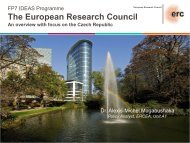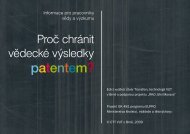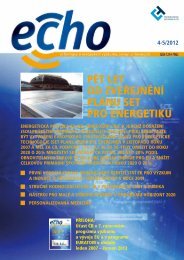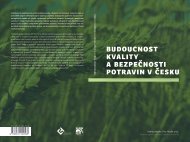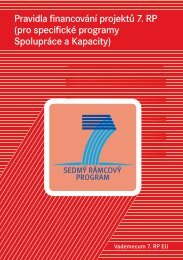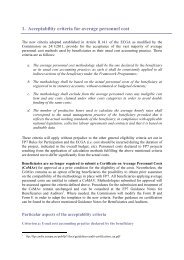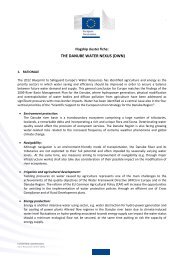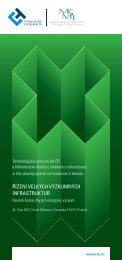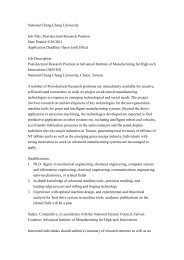Guide to Research and Innovation Strategies for Smart Specialisation
Guide to Research and Innovation Strategies for Smart Specialisation
Guide to Research and Innovation Strategies for Smart Specialisation
Create successful ePaper yourself
Turn your PDF publications into a flip-book with our unique Google optimized e-Paper software.
3. 'Cluster' in-depth case studies <strong>and</strong> peer reviews: <strong>to</strong> move beyond the figures that are<br />
available in a comparative way, more qualitative studies can be carried out on activity<br />
domains where a region shows relative specialisation. This involves expert work on value<br />
chain analysis (undertaken in an international perspective <strong>and</strong> enlightening the spatial<br />
division of labour), context conditions <strong>for</strong> the operation of the cluster, labour market<br />
situation, etc. It also involves an analysis of the linkages between the cluster <strong>and</strong> other<br />
clusters or industries, in order <strong>to</strong> examine whether one can talk about related variety across<br />
the areas of regional specialisation. One interesting approach is that of 'revealed skill<br />
relatedness' (RSR) method (Neffke <strong>and</strong> Svensson Henning 2009 22 ). RSR measures the<br />
degree <strong>to</strong> which industries share similar skills requirements, <strong>and</strong> this is seen as a very<br />
important vehicle <strong>for</strong> knowledge transfer between clusters (through people mobility). It is<br />
based on a network analysis using data on job changes between industries, showing<br />
proximity between industries in terms of skills sets.<br />
Sophisticated analyses of clusters such as Henning et al. (2010) 23 combine this type of<br />
analysis with a functional analysis linking economic structure with clusters challenges <strong>and</strong><br />
assessing the functions taken by the cluster initiative. The functions analysed are:<br />
knowledge creation <strong>and</strong> knowledge diffusion; identification of opportunities <strong>and</strong> barriers;<br />
stimulation of entrepreneurship/management of risk <strong>and</strong> uncertainty; market <strong>for</strong>mation;<br />
mobilisation of resources; legitimation. These types of analyses are conducted by experts<br />
who are studying the cases in close cooperation with cluster ac<strong>to</strong>rs: this helps taking in<strong>to</strong><br />
account the innovation opportunities as identified by leading ac<strong>to</strong>rs (companies,<br />
universities, intermediaries, etc.). Mixing regional experts with international experts helps<br />
<strong>to</strong> give more weight <strong>to</strong> the international competitiveness issue. Adding key stakeholders<br />
from <strong>for</strong>eign clusters brings in a useful peer review dimension <strong>to</strong> the analysis.<br />
4. Foresight: the aim of <strong>for</strong>esight is <strong>to</strong> capture existing expert intelligence sources on future<br />
trends <strong>and</strong> make them accessible <strong>for</strong> present decision-making. The role of <strong>for</strong>esight is <strong>to</strong><br />
elucidate possible paths <strong>for</strong> the future in order <strong>to</strong> open the debate on possible development<br />
paths. Foresight has the following characteristics 24 : Action-oriented; Open <strong>to</strong> alternative<br />
futures; Participa<strong>to</strong>ry; <strong>and</strong> Multidisciplinary. There is a multiplicity of methods that can be<br />
used <strong>and</strong> combined <strong>to</strong> implement <strong>for</strong>esight studies, the best known being the expert panels<br />
<strong>and</strong> multi-round Delphi surveys: they differ with respect <strong>to</strong> their expected benefits,<br />
conditions of use, time requirement, etc. Their common feature is that they rely heavily on<br />
expert knowledge <strong>and</strong> involve interactions between experts (Table 1; see more details on<br />
the FOREN website). For RIS3, <strong>for</strong>esight studies would ideally combine regional expertise<br />
with international expertise able <strong>to</strong> put regional assets in perspective with wider trends.<br />
22 Neffke, F. <strong>and</strong> M. Svensson Henning (2009), Skill-relatedness <strong>and</strong> firm diversification, Papers on Economics <strong>and</strong><br />
Evolution 0906. Jena Evolutionary Economics Group, Max Plank Institute of Economics.<br />
23 Henning, M., J. Moodysson <strong>and</strong> M. Nilsson (2010), <strong>Innovation</strong> <strong>and</strong> Regional Trans<strong>for</strong>mation: from clusters <strong>to</strong><br />
new combinations, Region Skane.<br />
24 European Commission (2001), FOREN <strong>Guide</strong> - Foresight <strong>for</strong> Regional Development Network - A Practical <strong>Guide</strong><br />
<strong>to</strong> Regional Foresight, IPTS Seville.<br />
33



